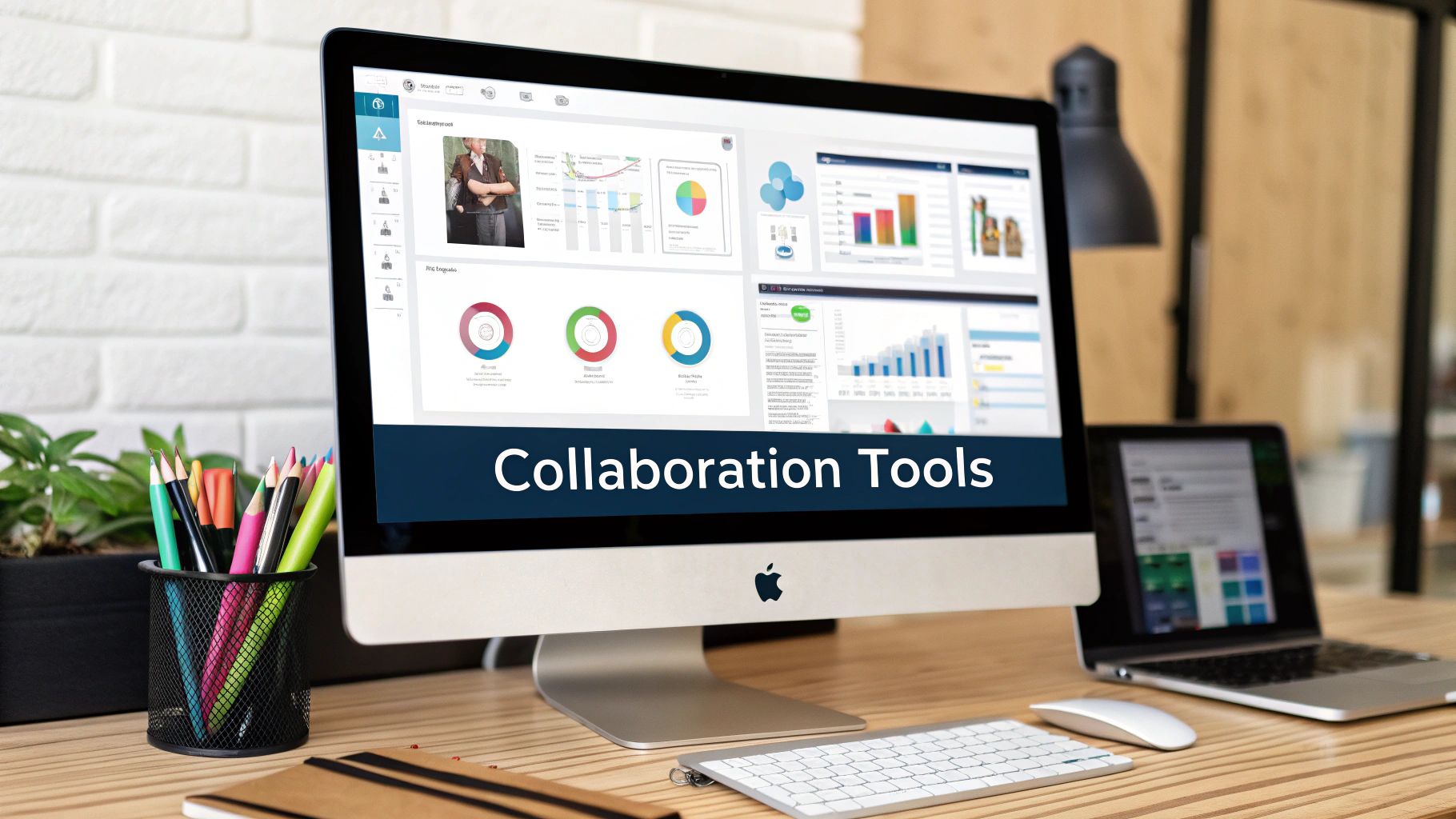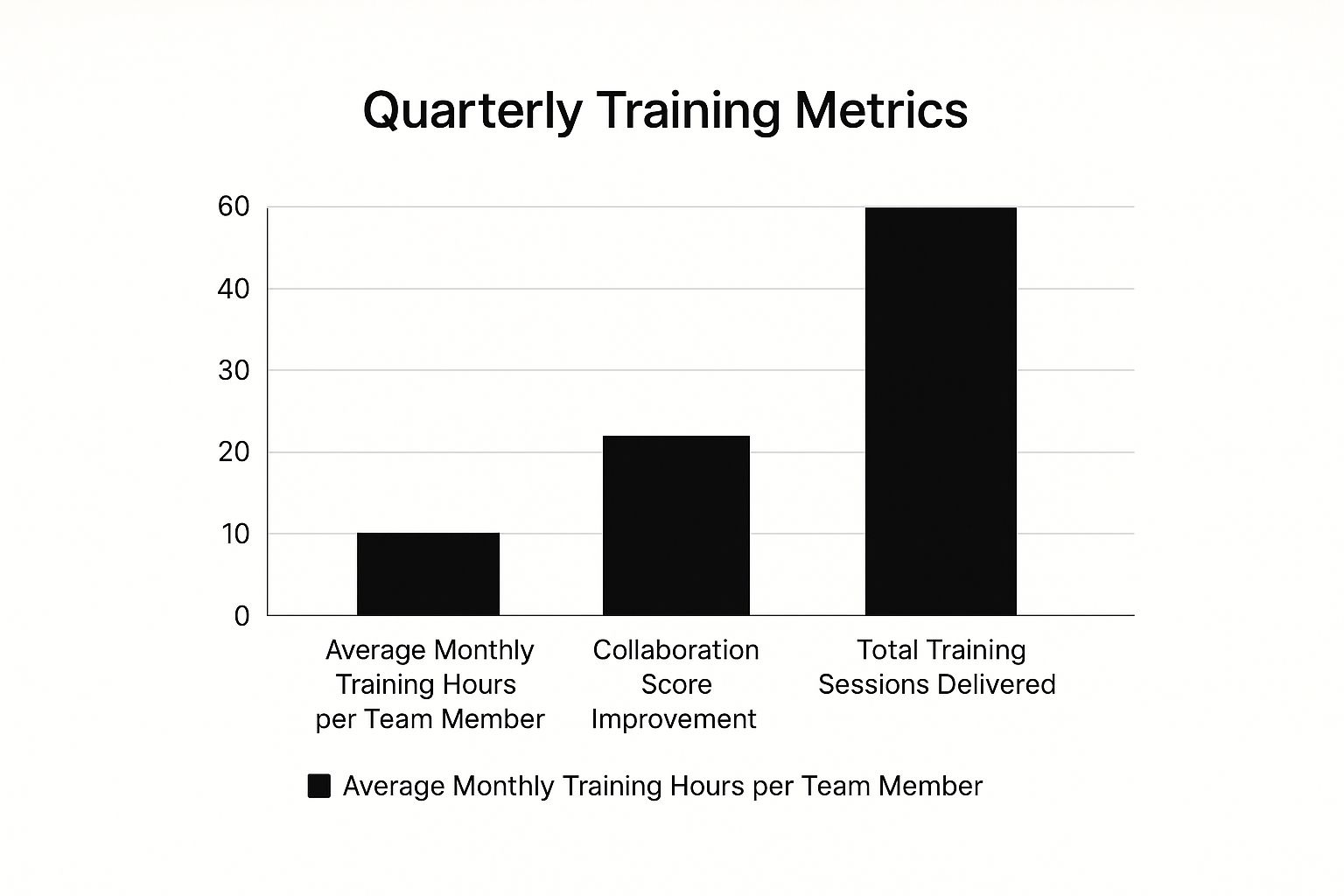Understanding What Makes Collaboration Actually Work
Understanding what makes collaboration work begins with ensuring your team members are on the same page and working towards shared objectives. Exploring different strategies to efficiently achieve team alignment is a crucial first step. Learn more about team alignment. Effective collaboration is more than just putting people in a room together and hoping for the best. It’s a nurtured process that requires understanding the elements that turn individual contributors into a high-performing team.
The Foundation of Effective Teamwork
Psychological safety is essential for any team looking to collaborate effectively. It’s an environment where team members feel comfortable taking calculated risks, sharing their ideas, and acknowledging mistakes without fear of being judged. This encourages open communication, which is crucial for problem-solving and innovation.
Shared accountability is another foundational element. This means everyone feels responsible for the team’s success and outcomes, not just their own individual tasks. This shared responsibility fosters a sense of ownership and motivates collective effort.
Debunking Collaboration Myths
Many organizations mistakenly believe that simply mandating collaboration will automatically produce positive results. This is a myth. Forced collaboration can actually be detrimental, breeding resentment among team members and hindering productivity.
For example, requiring teams to use specific tools like Slack or Microsoft Teams without proper training or a clear rationale can create frustration and resistance. This underscores the importance of aligning tools with team needs and providing the necessary support. The idea that all teams benefit from the same collaboration strategies is also a misconception. Each team has its own unique dynamics and requires a tailored approach.
Assessing Your Team’s Collaboration
To improve team collaboration, leaders need to understand where their team currently stands. This requires an honest evaluation and a willingness to address areas where the team could improve.
- Communication Analysis: Evaluate how effectively the team communicates. Are there any roadblocks or breakdowns in information sharing?
- Role Clarity: Does each team member understand their individual responsibilities and how they contribute to the overarching team goals?
- Conflict Resolution: How does the team handle disagreements? Are conflicts addressed constructively, or are they allowed to escalate?
Team collaboration is a critical factor in workplace success, and recent statistics underscore its importance. A 2024 Deloitte study revealed that 73% of employees who engage in collaborative work report increased performance. Additionally, 60% say that collaboration directly fuels their innovation. Find more collaboration statistics here. By identifying specific areas for improvement, leaders can implement targeted strategies to enhance collaboration and help their team reach its full potential. This data-driven approach is essential for optimizing team performance and producing significant results.
Building Genuine Human Connections That Drive Results

Exceptional collaboration isn’t just about having the right project management tools or processes. It’s about the human connections that make teamwork truly effective. In our increasingly digital world, where remote work and online communication are the norm, these connections are more important than ever. Strong interpersonal relationships directly impact how well a team functions. This section explores how to cultivate these vital connections and transform your team into a cohesive, high-performing unit.
The Power of Connection in a Digital World
While technology connects dispersed teams, it can also create distance. This can lead to misunderstandings and reduced productivity. However, when teams prioritize human connection, they unlock a new level of collaboration. A quick video call can often resolve a challenge more effectively than a long email chain. This is because human interaction allows for nuances like non-verbal cues and immediate feedback, fostering a shared understanding difficult to achieve through text.
Studies highlight the impact of interpersonal connections. Face-to-face or virtual interactions can improve collaboration by 23% compared to purely digital interactions. This underscores the value of human interaction. Explore this topic further. Gallup’s 2024 State of the Global Workplace report reveals only 21% employee engagement, further emphasizing the need for stronger workplace connections.
Fostering Meaningful Relationships
Building strong team relationships requires intentional effort and a varied approach.
- Structured Activities: Team-building activities, whether in-person or virtual, offer dedicated time for connection.
- Informal Interactions: Encourage casual conversations. Consider virtual coffee breaks, online social channels, or simply time for chat before or after meetings.
- Shared Experiences: Working towards shared goals naturally builds camaraderie. Celebrating milestones, big or small, strengthens team bonds.
Cultivating Psychological Safety
Psychological safety is critical for team collaboration. It allows individuals to express themselves without fear of judgment. This means creating an environment where team members feel comfortable:
- Sharing Bold Ideas: Without fear of ridicule, team members are more likely to contribute innovative solutions.
- Admitting Mistakes: Openly acknowledging errors enables faster learning and prevents repeated mistakes.
- Asking for Help: When supported, team members seek assistance when needed, avoiding delays and roadblocks. Read also: How to master task delegation.
This environment of trust and respect is essential for building genuine human connections. When team members feel connected and valued, they are more engaged, productive, and contribute their best work. By prioritizing authentic relationships, leaders can unlock their team’s full potential and achieve exceptional results.
Mastering Global And Remote Team Dynamics

Distributed teams are increasingly common, bringing exciting opportunities and unique collaboration challenges. Organizations must adapt to this new way of working, transcending geographical limits and embracing virtual interactions. This section explores the obstacles faced by global teams and offers effective strategies to overcome them. We’ll also examine how successful companies navigate the intricacies of global collaboration.
Navigating Time Zone Differences
One of the biggest hurdles for global teams is managing time zone differences. This can make scheduling meetings and maintaining consistent communication difficult. However, strategic planning can help.
Establishing core overlapping working hours, even just a few hours a day, allows for real-time interaction and faster decision-making. Using asynchronous communication methods, such as project management software and shared document platforms like Google Workspace, keeps everyone informed and projects moving forward, even when team members are offline. For more insights, check out our guide on cross-department collaboration.
Bridging Language and Cultural Gaps
Beyond time zones, language barriers and cultural differences can also hinder collaboration. Clear communication protocols and cultural sensitivity training are essential.
Encouraging team members to use clear, concise language and avoiding jargon and idioms can prevent misunderstandings. Providing multilingual resources and translation tools ensures everyone can access vital information. Fostering cultural awareness through workshops and team-building activities promotes respect and understanding, leading to stronger team cohesion.
According to Capterra’s 2024 Collaboration and Productivity Survey, 59% of employees working with international colleagues only started doing so within the past two years. 44% cite time differences as a major obstacle, 42% struggle with language barriers, and 33% report challenges related to cultural misunderstandings. Learn more about global team collaboration.
Building an Inclusive Virtual Environment
Creating an inclusive virtual environment is crucial for global team success. This means ensuring all team members feel valued, respected, and empowered to contribute, regardless of location or background.
Regular virtual team-building activities, social events, and opportunities for informal interaction foster a sense of community. This could be as simple as virtual coffee breaks or online team games. Actively soliciting feedback and creating open communication channels ensures every voice is heard and valued. This fosters a truly collaborative spirit.
The following table provides a regional breakdown of common collaboration challenges and satisfaction with meeting times.
Global Team Collaboration Challenges by Region
Comparison of collaboration obstacles faced by different regions and their satisfaction levels with meeting times
| Region | Primary Challenge | Time Difference (Avg Hours) | Meeting Satisfaction % |
|---|---|---|---|
| North America | Time Zone Differences | 6-9 | 75% |
| Europe | Language Barriers | 6-9 | 70% |
| Asia | Cultural Differences | 9-12 | 65% |
| South America | Time Zone Differences | 3-6 | 80% |
| Australia | Time Zone Differences | 9-12 | 60% |
As the table highlights, time zone differences are a significant challenge for North America, South America, and Australia, while language and cultural differences primarily affect Europe and Asia. Meeting satisfaction generally decreases as the average time difference increases.
By understanding these regional variations, organizations can implement targeted strategies to improve global team collaboration and create an environment where diverse perspectives and talents drive innovation and achieve shared goals. For further tips, see How to master cross-department collaboration.
Selecting Tools That Actually Enhance Productivity
The sheer volume of available collaboration platforms can feel overwhelming. Choosing the right tools is essential for effective teamwork and significantly impacts productivity. This section provides guidance on evaluating and implementing tools that genuinely boost output, rather than adding digital noise.
Evaluating Collaboration Software
Before exploring specific platforms, take time to analyze your team’s existing workflow. Pinpoint any friction points. Do communication breakdowns happen regularly? Is project tracking disorganized? The answers to these questions clarify which tools are truly necessary. When thinking about team motivation, consider offering remote employee gifts to inspire your remote workforce.
Next, categorize the types of software you actually need. These categories typically include:
- Communication Platforms: Tools like Slack or Microsoft Teams enable instant messaging, video conferencing, and file sharing. They streamline communication by providing a centralized hub.
- Project Management Systems: Asana, Jira, or Trello offer centralized project tracking, task assignment, and progress monitoring. They help keep projects organized and on schedule.
- Document Collaboration Tools: Google Workspace or Microsoft 365 allow real-time co-editing of documents, spreadsheets, and presentations. This fosters seamless teamwork and eliminates version control headaches.
Remember, an effective tool stack prioritizes quality over quantity. Avoid tool fatigue by choosing a manageable set of platforms that integrate seamlessly. This focused approach ensures your team spends time collaborating, not toggling between applications.
Implementing Tools Effectively
Selecting the right tools is just the first step. Effective implementation is crucial. Start with a pilot program involving a small group of team members. Gather their feedback and iterate based on their experiences. This approach allows for adjustments before full team rollout.
Provide comprehensive training and support. Team members need to understand not only how to use the new tools, but also why these tools are beneficial. This encourages buy-in and maximizes tool utilization.
Regularly evaluate tool usage and effectiveness. Are the tools truly improving communication and productivity? Are there any bottlenecks or areas of frustration? Ongoing evaluation is key to optimizing your technology stack over time. Research indicates that teams using optimized tools experience a 45% increase in productivity and 38% faster project completion. More detailed statistics can be found here.
Building Team Buy-In
Introducing new tools requires careful consideration of team dynamics. Resistance to change is common. Proactively address any concerns and involve team members in the decision-making process. This fosters a sense of ownership and minimizes pushback.
Clearly communicate the benefits of the new tools. Explain how they will simplify workflows, enhance communication, and ultimately make their work easier. This transparency promotes team buy-in and ensures a smoother transition. You might also be interested in learning about How to master HubSpot and Jira integration.
By focusing on careful evaluation, effective implementation, and proactive communication, you can create a technology ecosystem that truly enhances collaboration and drives team success. Choosing the right tools empowers teams to work smarter, not harder, and achieve shared objectives more efficiently.
Creating Crystal Clear Roles And Accountability Systems

Confusion can seriously hinder effective teamwork. This section emphasizes the importance of establishing clear roles, responsibilities, and objectives. This clarity allows teams to work together smoothly and efficiently, minimizing conflicts and maximizing results. We’ll explore frameworks for defining job roles, setting shared goals, and building accountability systems that encourage collaboration.
Defining Roles Without Silos
Well-defined roles are crucial, but they shouldn’t create isolated departments. Think of a soccer team: each player has a specific position, yet they work together towards a shared goal. Similarly, each team member should have distinct responsibilities while understanding how their individual work contributes to the overall team objective.
This interconnectedness fosters collaboration and prevents individuals from feeling isolated in their roles. It promotes a sense of shared purpose and makes it easier for team members to communicate and support one another. This approach ensures everyone is focused on the same outcome.
Setting Collaborative Goals
Collaborative goals link individual success with team achievement. These goals should be SMART: Specific, Measurable, Achievable, Relevant, and Time-bound. For example, instead of a general goal like “improve customer satisfaction,” a SMART goal would be “increase customer satisfaction scores by 15% within the next quarter.”
This specific approach provides clear direction and allows for accurate progress tracking. When individuals see how their work directly contributes to the team’s success, they are more likely to be engaged and motivated. This positive feedback loop creates a culture of collaboration and achievement.
Establishing Accountability Systems
Accountability systems encourage cooperation, not competition. These systems should focus on shared responsibility and mutual support. Regular check-ins, progress updates, and open communication are vital. Think of it like a rowing team: every member is accountable for their individual performance, but they all work together to propel the boat forward.
Teams with defined roles and accountability have 67% fewer project delays and 52% higher satisfaction. You can find more detailed statistics here. This clearly demonstrates the benefits of structure and clarity on team performance.
Conducting Effective Check-Ins
Regular check-ins are opportunities to track progress, identify roadblocks, and offer support. These meetings should be focused and action-oriented. Start by reviewing progress towards established goals. Then, discuss any challenges the team is facing. Finally, work together to develop solutions and assign specific action items.
This process ensures everyone leaves the meeting with a clear understanding of the next steps. Regular communication keeps the team aligned and on track.
Tracking Meaningful Progress Indicators
Tracking the right metrics is crucial for measuring team success. Choose key performance indicators (KPIs) that directly reflect the team’s goals. For example, if the goal is to improve customer satisfaction, track metrics like customer satisfaction scores, customer churn rate, and customer lifetime value.
This data provides valuable insights into team performance and facilitates data-driven decision-making. Regularly reviewing these KPIs helps identify areas for improvement and ensures the team remains focused on achieving its goals.
Implementing Course Corrections
No plan is ever perfect. It’s important to be flexible and adapt as needed. Regularly review progress and be prepared to adjust strategies when necessary. This may involve revisiting goals, redefining roles, or implementing new tools or processes.
The key is to be proactive and make adjustments before small issues become major problems. This agile approach ensures the team stays aligned and continues to move forward efficiently. By embracing flexibility and continuous improvement, teams can navigate challenges and achieve lasting success.
Optimizing Team Size For Maximum Collaborative Impact
Not all teams are created equal. Size significantly impacts a team’s collaborative effectiveness, often more than leaders realize. This section explores the ideal team composition, providing insights into what makes teams thrive at different scales. We’ll examine how team size directly affects communication, decision-making, and overall productivity. We’ll also cover practical strategies for structuring larger teams into smaller, more agile units, while preserving coordination across the organization.
The Impact of Team Size on Collaboration
Team size influences several key aspects of collaboration:
- Communication Efficiency: Smaller teams often communicate more effectively. With fewer individuals involved, messages are transmitted and understood more quickly. This reduces the risk of miscommunication and streamlines project execution.
- Decision-Making Speed: Smaller teams can typically reach decisions faster than larger ones. This agility is invaluable in fast-paced environments where responsiveness is key. However, a team that’s too small can lack diverse perspectives, hindering effective problem-solving.
- Productivity Outcomes: The relationship between team size and productivity is complex. While larger teams can theoretically accomplish more due to increased manpower, they can also suffer from decreased individual output due to coordination overhead and diffusion of responsibility.
Finding the optimal balance is crucial. Larger teams, while having the potential for diverse thought, can become bogged down in complex communication channels. This can lead to a slower decision-making process, potentially hindering implementation, a crucial aspect highlighted by Professor Len Schlesinger at Harvard Business School.
Let’s explore the impact of team size with some data. The following table shows how different team sizes affect key performance indicators.
To understand these dynamics better, let’s analyze some data. The table below, “Team Size Impact on Collaboration Effectiveness,” illustrates how varying team sizes influence key performance indicators.
| Team Size | Communication Efficiency | Decision Speed | Productivity Score | Recommended For |
|---|---|---|---|---|
| 3-5 | High | Fast | Medium | Focused tasks, rapid prototyping |
| 6-9 | Medium | Medium | High | Complex projects, diverse input |
| 10+ | Low | Slow | Medium | Large-scale initiatives, specialized sub-teams |
This data highlights the trade-offs between team size, communication, decision speed, and productivity. Smaller teams excel in communication and quick decision-making, while larger teams, when properly structured, can achieve higher productivity through specialization.

As this infographic demonstrates, targeted training initiatives can significantly improve team collaboration. Increased training correlates with better collaboration scores and a higher frequency of training sessions.
Structuring Teams for Optimal Performance
For larger projects, breaking down teams into smaller, specialized units can improve efficiency. These smaller teams, typically ranging from five to seven members, benefit from focused communication and faster decision-making.
However, maintaining connection and coordination between these sub-teams is vital. Regular cross-team meetings, shared project management tools like the HubSpot for Jira integration, and clear communication protocols ensure everyone stays aligned and prevents fragmentation.
Preventing Communication Breakdowns
One of the biggest challenges facing larger teams is communication breakdown. This can lead to duplicated work, conflicting priorities, and missed deadlines.
Establishing clear communication channels, designating roles for communication responsibilities, and implementing shared project management tools can mitigate these issues. Regular team meetings, both within sub-teams and across the larger group, are crucial for information sharing and problem-solving.
When to Split Teams
Recognizing when a team has become too large is crucial. If communication becomes cumbersome, decision-making slows, or individual productivity decreases, it might be time to consider restructuring.
This is particularly important in agile environments where speed and responsiveness are paramount. As teams grow, consider appointing team leaders to manage smaller segments for more effective discussions. This can prevent the “consensus” trap, where decisions are made by reaching general agreement, potentially hindering creative solutions, as noted by Harvard Business School Professor Schlesinger.
By implementing these strategies, organizations can optimize team size for maximum impact. Creating smaller, more agile teams, maintaining clear communication, and utilizing the right tools ensure effective collaboration, higher productivity, and ultimately, greater success. Boosting employee engagement through these strategies can further enhance outcomes and reduce burnout.
Key Takeaways
This practical roadmap will enhance your team’s collaboration with actionable strategies and steps you can implement today. Each takeaway focuses on measurable progress, providing specific indicators to track success. We’ll provide checklists to assess your current collaboration, proven frameworks for continuous improvement, and honest, context-specific guidance.
Prioritize Genuine Human Connection
While tools and processes are essential, true collaboration hinges on human connection. Especially with the rise of remote and hybrid work, personal bonds between team members are more critical than ever. Building rapport through informal interactions, team-building activities, and shared experiences fosters trust and open communication.
This positive environment increases psychological safety, encouraging team members to share ideas freely, admit mistakes without fear, and readily ask for help. Ultimately, this significantly improves collaboration, productivity, and overall team performance.
Establish Crystal-Clear Roles and Accountabilities
Ambiguity creates confusion and hinders collaboration. Teams thrive when everyone understands their individual responsibilities and how they contribute to shared goals. Clearly defined roles and a common understanding of accountabilities provide a crucial structure for collaborative efforts.
This clarity minimizes conflict and promotes synergy. However, well-defined roles shouldn’t create silos. Each team member should understand their own contributions while also recognizing how their work connects with everyone else’s. This holistic view prevents the team from becoming a collection of isolated individuals and fosters a unified, collaborative approach.
Embrace the Right Tools, Not All the Tools
Technology should simplify collaboration, not overwhelm your team. Too many disconnected tools can lead to frustration and reduced productivity. Choosing the right tools for your team’s specific needs is paramount. Consider focusing on these key areas:
- Communication Platforms: Streamline real-time interactions with tools like Slack or Microsoft Teams. These platforms are particularly beneficial for teams requiring quick collaboration and rapid feedback.
- Project Management Systems: Maintain project organization and track progress effectively using tools like Asana, Jira, or Trello. These systems help keep projects on schedule and within scope.
- Document Collaboration Tools: Facilitate real-time co-editing and version control with platforms like Google Workspace or Microsoft 365. These tools ensure everyone has access to the most current documents and resources.
Avoid tool fatigue by choosing a select number of platforms that integrate smoothly. Involve team members in the evaluation and decision-making process and offer thorough training.
Optimize Team Size for Collaborative Success
Team size significantly affects effectiveness. Smaller teams often communicate more efficiently and make quicker decisions. Larger teams, when structured correctly, can benefit from specialized expertise and potentially higher output. However, larger teams also face communication difficulties. Implementing clear communication protocols, assigning communication roles, and leveraging shared tools can address these challenges.
The table below, “Team Size Impact on Collaboration Effectiveness,” illustrates this relationship:
| Team Size | Communication Efficiency | Decision Speed | Productivity Score |
|---|---|---|---|
| 3-5 | High | Fast | Medium |
| 6-9 | Medium | Medium | High |
| 10+ | Low | Slow | Medium |
Mid-sized teams often achieve the highest productivity, balancing efficiency with sufficient manpower. This underscores the importance of thoughtful team structuring, particularly as organizations grow. Restructuring larger teams into smaller units, perhaps with team leaders, can improve communication and decision speed, mitigating the potential drawbacks of consensus-driven decisions.
Foster a Culture of Continuous Improvement
Effective teamwork isn’t a destination but a journey. Regularly assess your team’s collaborative efforts. Analyze communication flows, identify areas for improvement, and acknowledge achievements. Implement changes gradually, soliciting feedback from team members, and adjusting your approach as needed. This commitment to continuous improvement creates a dynamic environment where collaboration thrives, driving both individual and team success.
For seamless collaboration between your sales, marketing, and development teams using HubSpot and Jira, consider resolution’s HubSpot for Jira integration. It provides a powerful solution to unify data, streamline communication, and boost overall productivity.
